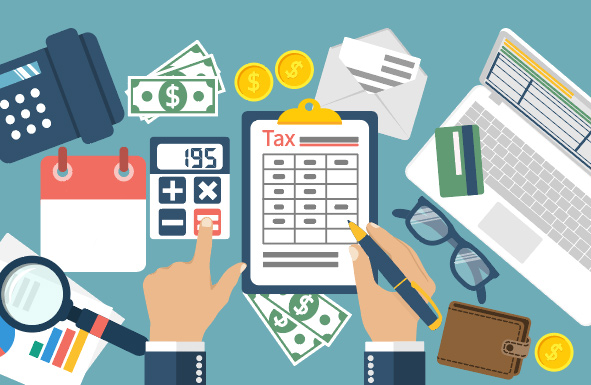It’s hard to believe 2019 is almost over! It’s been a busy year in many sectors, often forcing small business owners to put tax planning on the back burner while they’ve tended to daily business operations.
But procrastinate no longer. Consider the following moves to lower your 2019 business tax bill before ringing in the New Year.
Time Income and Deductions from Pass-Through Entities
Most small businesses are set up as sole proprietorships or “pass-through” entities, such as partnerships, S corporations and limited liability companies (LLCs) that are treated as partnerships for tax purposes. Income and deductions from pass-through entities are allocated to the owners based on their ownership percentage in their businesses. Your pro rata share of a pass-through entity’s net income is taxed at your personal rates.
Under the Tax Cuts and Jobs Act (TCJA), individual federal income tax rate brackets will basically be the same for 2019 and 2020, with modest adjustments for inflation. (See “2019 and 2020 Individual Tax Brackets” below.)
So, the traditional strategy of deferring income from these entities into next year while accelerating deductible expenditures into this year makes sense if you expect to be in the same or a lower tax bracket next year. Deferring income and accelerating deductions will, at a minimum, postpone part of your tax bill from 2019 until 2020.
However, if you expect to be in a higher tax bracket in 2020, take the opposite approach. Accelerate income into this year (if possible) and postpone deductible expenditures until 2020. That way, more income will be taxed at this year’s lower rate instead of next year’s higher rate.
Do You Have a Tax-Favored Retirement Plan?
If your business doesn’t already have a retirement plan, it might be time to take the plunge. Current rules allow for significant deductible contributions.
For example, if you’re self-employed and set up a SEP-IRA, you can contribute up to 20% of your self-employment earnings, with a maximum contribution of $56,000 for 2019. If you’re employed by your own corporation, you can contribute up to 25% of your salary to your account, with a maximum contribution of $56,000.
Other small business options include defined benefit pension plans, SIMPLE-IRAs, and 401(k) plans. You can even set up a solo 401(k) plan for just one person. Depending on your circumstances, these other types of plans may allow bigger deductible contributions.
Important note: If your business has employees, your plan may have to cover them, too.
The deadline for setting up a SEP-IRA for a sole proprietorship business and making the initial deductible contribution for the 2019 tax year is October 15, 2020, if you extend your 2019 return to that date. Other plans generally must be established by December 31, 2019, if you want to make a deductible contribution for the 2019 tax year. But the deadline for the contribution itself is the extended due date for your 2019 return.
There’s one exception: To make a SIMPLE-IRA contribution for 2019, you must have set up the plan by October 1, 2019. So, you might have to wait until next year if you prefer the SIMPLE-IRA option.
Maximize the Deduction for Income from a Pass-Through Entity
Under current tax law, owners of pass-through entities (including sole proprietorships) may be eligible for a deduction based on qualified business income (QBI) for tax years beginning in 2018 through 2025. The deduction can be up to 20% of a pass-through entity owner’s QBI, subject to restrictions that can apply at higher income levels and another restriction based on the owner’s taxable income.
The QBI deduction is available only to noncorporate taxpayers, meaning individuals, trusts and estates. It also can be claimed for up to 20% of income from qualified real estate investment trust (REIT) dividends and 20% of qualified income from publicly traded partnerships (PTPs).
Because of various limitations on the QBI deduction, tax planning can help increase your allowable QBI deduction. For example, before year end, you might be able to increase W-2 wages or purchase additional business assets to help boost your QBI deduction.
Also, be aware that moves designed to reduce this year’s taxable income (such as postponing revenue or accelerating expenses) can inadvertently reduce your QBI deduction. Work with your tax pro to anticipate any adverse side effects of other tax planning strategies and optimize your results on this year’s return.
Claim 100% Bonus Depreciation for Asset Additions
Under current law, 100% first-year bonus depreciation is available for qualified new and used property that’s acquired and placed in service in calendar year 2019. That means your business might be able to write off the entire cost of some (or all) of your 2019 asset additions on this year’s return.
Bonus depreciation isn’t subject to any spending limits or income-based phaseout thresholds. But the program will be gradually phased out, starting in 2023, unless Congress extends it.
Consider buying some extra equipment, furniture, computers or other fixed assets before year end. Your tax advisor can explain what types of assets qualify for this break.
One type of asset that could deliver a big write-off on your 2019 tax return is a “heavy” vehicle. Heavy SUVs, pickups and vans that are used over 50% for business are treated for tax purposes as transportation equipment. So, they qualify for 100% bonus depreciation.
Specifically, bonus depreciation is available when the SUV, pickup or van has a manufacturer’s gross vehicle weight rating (GVWR) above 6,000 pounds. You can verify a vehicle’s GVWR by looking at the manufacturer’s label, which is usually found on the inside edge of the driver’s side door (where the door hinges meet the frame).
Cash in on More Generous Section 179 Deduction Rules
For qualifying property placed in service in tax years beginning in 2019, the TCJA increased the maximum Sec. 179 expensing amount to $1 million, adjusted annually for inflation. For 2019, the inflation-adjusted amount is $1.02 million. (Under prior law, the limit was $510,000 for tax years beginning in 2017.)
The TCJA provides other beneficial changes to the Sec. 179 expensing rules, including:
Property used for lodging. The TCJA repealed the prior-law provision that excluded from Sec. 179 expensing personal property used to furnish lodging. So now eligible property qualifies for a tax break. This change goes into effect for property placed in service in tax years beginning in 2018 and beyond. Examples of such property include:
- Furniture,
- Kitchen appliances,
- Lawnmowers, and
- Other equipment used in the living quarters of a lodging facility or in connection with a lodging facility, such as a hotel, motel, apartment house, rental condo or rental single-family home.
Qualifying real property. Sec. 179 expensing can be claimed for qualifying real property expenditures, up to the maximum annual allowance. There’s no separate limit for qualifying real property expenditures, so Sec. 179 deductions claimed for real property reduce the maximum annual allowance dollar for dollar.
Qualifying real property refers to any improvement to an interior portion of a nonresidential building that’s placed in service after the date the building is first placed in service. However, costs attributable to the enlargement of a building, any elevator or escalator, or the building’s internal structural framework don’t qualify.
For tax years beginning in 2018 and beyond, the TCJA expanded the definition of real property eligible for Sec. 179 expensing to include qualified expenditures for roofs, HVAC equipment, fire protection and alarm systems, and security systems for nonresidential real property. These items must be placed in service in tax years beginning after 2017, and after the nonresidential building has been placed in service.
Important note: Various limitations apply to Sec. 179 expensing deductions, especially if you conduct your business as a pass-through entity.
Sell Qualified Small Business Stock
A 100% federal gain exclusion break is potentially available when you sell qualified small business corporation (QSBC) stock that was acquired after September 27, 2010. That equates to a 0% federal income tax rate if the shares are sold for a gain.
However, you must hold the shares for more than five years to benefit from this break. Be aware that it’s not available to QSBC stock that’s owned by a C corporation. Plus, many companies won’t meet the definition of a QSBC in the first place. Your tax professional can help explain the details.
Meet with Your Tax Pro Before Year End
A positive side effect of congressional gridlock is that the tax law hasn’t changed much over the last year. Most TCJA provisions that affect small businesses went into effect in 2018, and the year-end tax planning strategies that worked for 2018 are generally valid for the current tax year.
However, your specific business situation might have changed. Don’t assume that last year’s strategies will minimize your 2019 tax bill. Work with your tax pro to identify the optimal year-end tax planning moves based on your current circumstances.
2019 and 2020 Individual Tax Brackets
| 2019 Individual Federal Income Tax Brackets |
| Single | Married, Filing Jointly | Head of Household |
| 10% tax bracket | $0 – $9,700 | $0 – $19,400 | $0 – $13,850 |
| Beginning of 12% bracket | $9,701 | $19,401 | $13,851 |
| Beginning of 22% bracket | $39,476 | $78,951 | $52,851 |
| Beginning of 24% bracket | $84,201 | $168,401 | $84,201 |
| Beginning of 32% bracket | $160,726 | $321,451 | $160,701 |
| Beginning of 35% bracket | $204,101 | $408,201 | $204,101 |
| Beginning of 37% bracket | $510,301 | $612,351 | $510,301 |
| Projected 2020 Individual Federal Income Tax Brackets |
| Single | Married, Filing Jointly | Head of Household |
| 10% tax bracket | $0 – $9,875 | $0 – $19,750 | $0 – $14,100 |
| Beginning of 12% bracket | $9,876 | $19,751 | $14,101 |
| Beginning of 22% bracket | $40,126 | $80,251 | $53,701 |
| Beginning of 24% bracket | $85,526 | $171,051 | $85,501 |
| Beginning of 32% bracket | $163,301 | $326,601 | $163,301 |
| Beginning of 35% bracket | $207,351 | $414,701 | $207,351 |
| Beginning of 37% bracket | $518,401 | $622,051 | $518,401 |
——————–
© 2019, Provided by Thomson Rueters Checkpoint






